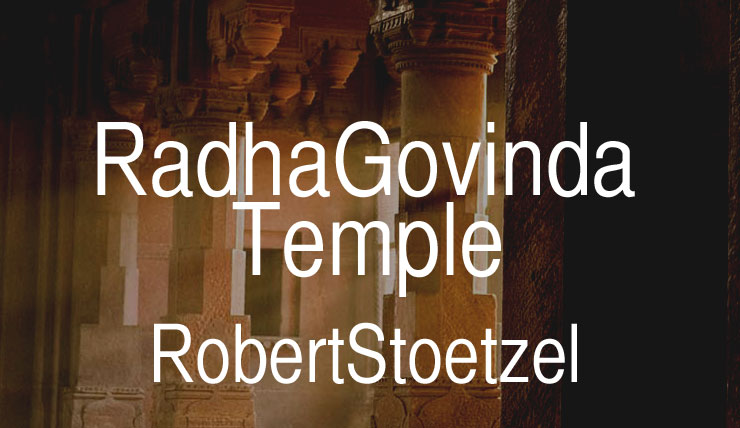
divyad-vrndaranya-kalpa-drumadah
srimad-ratnagara-simhasana-sthau
sri-sri-radha-srila-govinda-devau
presthalibhih sevyamanau smarami
In a temple of jewels in Vrndavana, underneath a desire tree, Sri Sri Radha Govinda, served by Their most confidential associates, sit upon an effulgent throne. I offer my humble obeisances unto Them. [Sri Caitanya Caritamrita Adi 1.16]
The Radha Govinda Temple is seen as one of the most impressive examples of North Indian architecture. It sits in the middle of the Yogapitha, the sacred place where Radha and Krishna would meet.
The deity of Govinda, believed to have been established thousands of years ago by Krishna’s grandson Vajranaba, was rediscovered by Srila Rupa Goswami in the 16th century. The construction of the temple was begun under the direction of Raghunath Bhatta Goswami and his disciples, headed by Raja Man Singh (a general in the Army of Emperor Akbar) and was completed in 1590. Jiva Goswami praised Emperor Akbar in his Govindam Mandir Astakam (Eight Prayers in Glorification of the Govinda Temple), which is carved into the temple’s stone. The inscription reads “Emperor Akbar is a very kind-hearted person and a Vaishnava. I give my blessings to Emperor Akbar. In his kingdom all the Vaishnavas are living very peacefully.”
Less than 100 years later Emperor Aurangzeb ordered the temple’s destruction. Before his soldiers arrived the deities of Radha and Govinda were moved. They now reside in the grand Govindaji temple in Jaipur.
Before its destruction the temple stood seven stories high. Just two stories remain. Still, the Radha Govinda Temple remains a towering monument to Lord Govinda and a place where one can feel a connection to the great saints of the past and the history of Krishna devotion in Vrindavan.
Kaustubha das
Robert Stoetzel is a New York based photographer traveling and photographing in India trough March 2009.
Comments
3 responses to “Radha Govinda Temple / Photos by Robert Stoetzel”
Wow! That is really a beautiful temple! Sad it didn’t get to go there more often. The monkeys scare me!!!
If it was 7 stories high… what was on the higher floors???
Vraja, you’ve got to get over your Maimouphobia (fear of monkeys). It’s getting in the way of your pilgrimages.
I don’t know much about the higher floors. I spoke with HH Radhanath Swami about it once and, if I remember correctly, he said that they were more of a tower. In other words they were decorative. The story goes that, seeing a large oil lamp burning on the top floor, Arungzeb (who happened to be the great grandson of the temple’s sponsor Akbar) became infuriated that the tallest building in the area was a Hindu temple. While his soldiers were tearing down the upper floors the Earth began to violently shake and they ran off, their destruction incomplete. Still, having been desecrated, the temple was seen as unfit for Govinda who was brought to be worshiped in Jaipur, where the Hindu kings were strong. The Govindaji Temple in Jaipur is super wonderful with thousands of visitors daily, all singing beautiful songs and passing out prasad. I’m hopeful that Robert will send us some photos of Jaipur soon.
Some details from the photos.
1. You can see some of the monkeys that Vraja Kishor is speaking of in image 2 (on the left side of the steps), and image 6 (there are four of them on the floor).
2. You can get an idea of how meticulously the temple is decorated with carvings in images 5 (there are carvings of Krishna’s lilas bordering the doorway, and above the doorway is a carving of Krishna lifting Govardhana Hill) and 7 (a huge sandstone lotus, weighing several tons, fixed on the center of the ceiling).
Wonderful stuff, Mr. Stoetzel. Please continue.